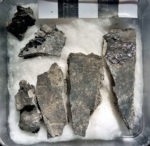The skull of a young man who died in the eruption of Vesuvius in 79 A.D. has been found to contain the remains of his brain, but not in any of the mummified, saponified or even Heslington varieties seen before in an archaeological context. His brain was turned to glass.
 The skeletal remains of an adult male about 25 years of age when he died were discovered in a small room believed to be the caretaker’s bed chamber in the Collegium Augustalium, the headquarters of the cult of the deified Augustus, in 1961. The bones were on top of a bank of volcanic ash from the eruption. Pieces of the wooden bed he had been lying on were visible inside the bank. He was found in prone position face down, or rather what-was-left-of-his-face down. The heat of the pyroclastic surge had made his skull burst. Section of his exploded and charred skull were found in a rough semi-circle around the top of the bed. The bones of his chest were encased in a solidified spongy mass, likely formed by the combination of lungs and organs with volcanic material. Small bits of pumice are embedded in there.
The skeletal remains of an adult male about 25 years of age when he died were discovered in a small room believed to be the caretaker’s bed chamber in the Collegium Augustalium, the headquarters of the cult of the deified Augustus, in 1961. The bones were on top of a bank of volcanic ash from the eruption. Pieces of the wooden bed he had been lying on were visible inside the bank. He was found in prone position face down, or rather what-was-left-of-his-face down. The heat of the pyroclastic surge had made his skull burst. Section of his exploded and charred skull were found in a rough semi-circle around the top of the bed. The bones of his chest were encased in a solidified spongy mass, likely formed by the combination of lungs and organs with volcanic material. Small bits of pumice are embedded in there.
The entrapped chest was unique for a victim of Vesuvius’ 79 A.D. eruption, as was another feature: a glassy black material filling the cranial cavity and  encrusted on the inner surface of the bone fragments. While there were areas on the left tibia and a rib fragment that were partially glass-like in appearance, they were much less glossy and largely retained their original structure.
encrusted on the inner surface of the bone fragments. While there were areas on the left tibia and a rib fragment that were partially glass-like in appearance, they were much less glossy and largely retained their original structure.
University of Naples Federico II forensic anthropologist Dr. Pier Paolo Petrone was studying the Collegium Augustalium remains when he noticed the black glassy texture in the cranium.
“I noticed something shining inside the head,” he told the Guardian. “This material was preserved exclusively in the victim’s skull, thus it had to be the vitrified remains of the brain. But it had to be proved beyond any reasonable doubt.”
Gas Chromatography-Mass Spectrometry analysis of the protein content of the glassy material in the cranium found fatty acids that are specific to brain tissue, suggesting that Vesuvius turned this man’s brain was to glass.
From the results published New England Journal of Medicine:
Proteomic investigation of the glassy material inside the skull identified several proteins that are highly expressed in human brain tissues (Table S1). Adipic and margaric fatty acids, components of human hair fat from sebum, were detected exclusively in the glassy fragments (Table S2) but not in the adjacent ash or in charcoal from the archaeological site. Fatty acids that are typical of human brain triglycerides were also found in the putative brain material. These substances are common to animals and plants (Table S3); however, no evidence of plants or animals was found at the site from which the victim was recovered.
Features suggesting a maximum temperature of 520°C were detected on charred wood from the Collegium (Fig. S5). This suggests that extreme radiant heat was able to ignite body fat and vaporize soft tissues; a rapid drop in temperature followed. The detection of glassy material from the victim’s head, of proteins expressed in human brain, and of fatty acids found in human hair indicates the thermally induced preservation of vitrified human brain tissue.
Vitrification is a rare phenomenon on the archaeological record. Most of the vitrified material that has been discovered is charcoal, dry wood that converted to glassy hardness in an inferno of around 310-530°C.